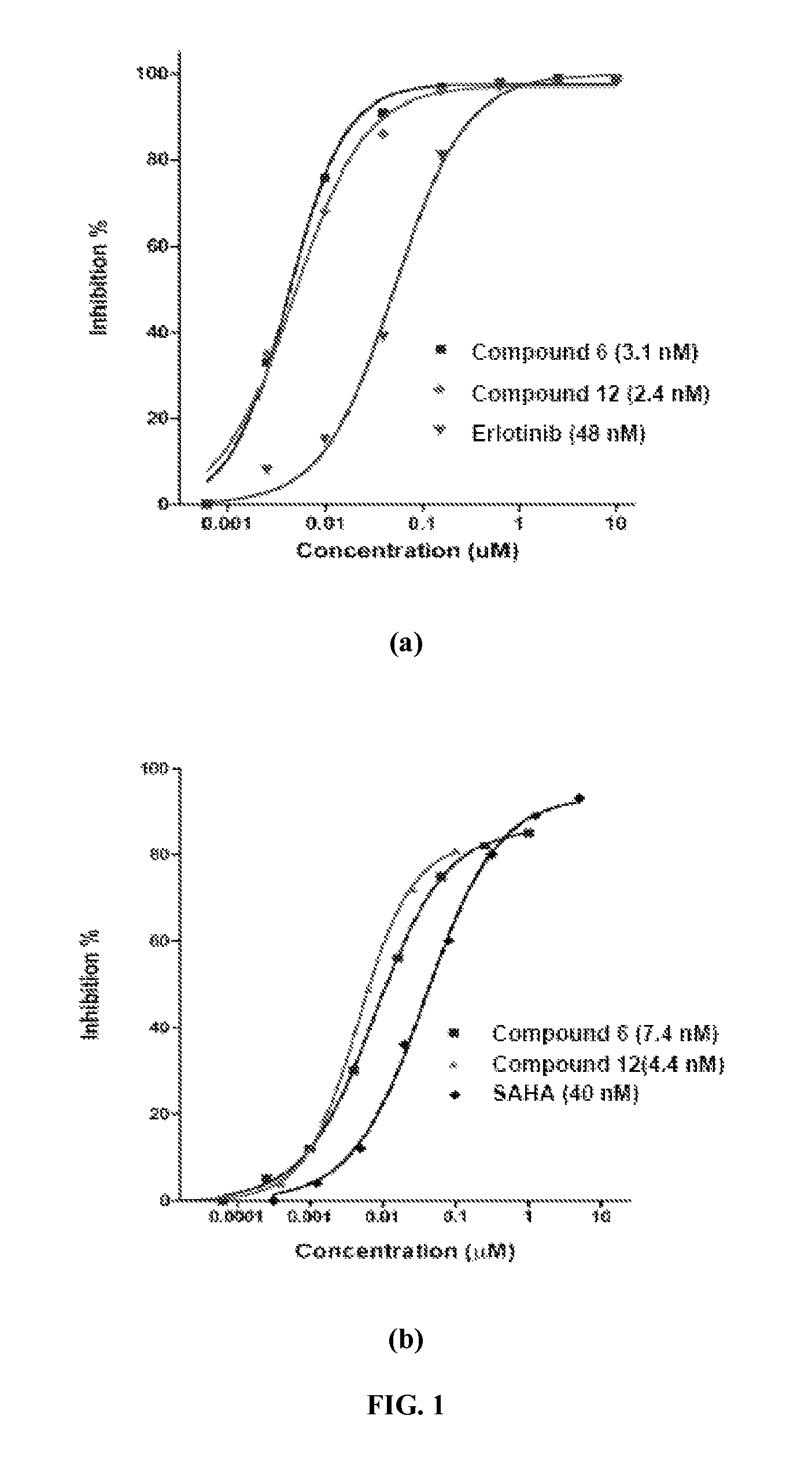Quinazoline based EGFR inhibitors containing a zinc binding moiety
a technology of zinc binding moiety and egfr inhibitor, which is applied in the direction of biocide, organic chemistry, drug composition, etc., can solve the problems of limited ability to use such combinations, high cost and long regulatory requirements for demonstrating safety and efficacy of combination therapies, and often limited treatment regimes using cytotoxic cocktail drugs. achieve enhanced activity, enhance and unexpected properties, and inhibit hdac and/or matrix metalloproteinase activity
- Summary
- Abstract
- Description
- Claims
- Application Information
AI Technical Summary
Benefits of technology
Problems solved by technology
Method used
Image
Examples
example 1
Preparation of 2-(4-(3-Chloro-4-fluorophenylamino)-7-methoxyquinazolin-6-yloxy)-N-hydroxyacetamide (Compound 1)
Step 1a. 6,7-Dimethoxyquinazolin-4(3H)-one (Compound 0102)
[0239]A mixture of methyl 2-amino-4,5-dimethoxybenzoic acid 0101 (2.1 g, 10 mmol), ammonium formate (0.63 g, 10 mmol) and formamide (7 ml) was stirred and heated to 190˜200° C. for 2 hours. Then the mixture was cooled to room temperature. The precipitate was isolated, washed with water and dried to provide the title compound 0102 as a brown solid (1.8 g, 84.7%): LCMS: m / z 207 [M+1]+; 1H NMR (DMS) δ 3.87 (s, 3H), 3.89 (s, 3H), 7.12 (s, 1H), 7.43 (s, 1H), 7.97 (s, 1H), 12.08 (bs, 1H).
Step 1b. 6-Hydroxy-7-methoxyquinazolin-4(3H)-one (Compound 0103)
[0240]6,7-Dimethoxyquinazolin-4(3H)-one (0102) (10.3 g, 50 mmol) was added portionwise to stirred methanesulphonic acid (68 ml). L-Methionone (8.6 g, 57.5 mmol) was then added and resultant mixture was heated to 150˜160° C. for 5 hours. The mixture was cooled to room temperatu...
example 2
Preparation of 4-(4-(3-Chloro-4-fluorophenylamino)-7-methoxyquinazolin-6-yloxy)-N-hydroxybutanamide (Compound 3)
Step 2a. Ethyl 4-(4-(3-chloro-4-fluorophenylamino)-7-methoxyquinazolin-6-yloxy)butanoate (Compound 0110-3)
[0248]The title compound 0110-3 was prepared as a yellow solid (220 mg, 80.5%) from compound 0109 from step 1f (200 mg, 0.63 mmol) and ethyl 4-bromobutyrate (135 mg, 0.69 mmol) using a procedure similar to that described for compound 0110-1 (example 1): LCMS: m / z 434 [M+1]+; 1H NMR (CDCl3) δ 1.36 (t, 3H), 2.23 (m, 2H), 2.57 (t, 2H), 4.03 (s, 3H), 4.32 (m, 4H), 7.15 (t, 1H), 7.25 (m, 1H), 7.87 (s, 1H), 8.00 (m, 2H), 8.15 (bs, 1H), 8.57 (s, 1H).
Step 2b. 4-(4-(3-Chloro-4-fluorophenylamino)-7-methoxyquinazolin-6-yloxy)-N-hydroxybutanamide (Compound 3)
[0249]The title compound 3 was prepare as a grey solid (25 mg, 12%) from compound 0110-3 (200 mg, 0.23 mmol) using a procedure similar to that described for compound 1 (Example 1): LCMS: m / z 421 [M+1]+; 1H NMR (DMSO): δ 2.06 (...
example 3
Preparation of 7-(4-(3-Chloro-4-fluorophenylamino)-7-methoxyquinazolin-6-yloxy)-N-hydroxyhexanamide (Compound 5)
Step 3a. Ethyl 6-(4-(3-chloro-4-fluorophenylamino)-7-methoxyquinazolin-6-yloxy)hexanoate (Compound 0110-5)
[0250]The title compound 0110-5 was prepared as a yellow solid (510 mg, 68%) from compound 0109 from step 1f (510 mg, 1.6 mmol) and ethyl 6-bromohexanoate (430 mg, 1.9 mmol) using a procedure similar to that described for compound 0110-1 (Example 1): LCMS: m / z 462 [M+1]+; 1H NMR (CDCl3): δ 1.24 (t, 3H), 1.55 (m, 2H), 1.74 (m, 2H), 1.91 (m, 2H), 2.38 (m, 2H), 3.97 (s, 3H), 4.13 (m, 4H), 7.15 (t, 1H), 7.25 (m, 2H), 7.60 (m, 1H), 7.86 (m, 1H), 7.91 (dd, 1H), 8.61 (s, 1H).
Step 3b. 7-(4-(3-Chloro-4-fluorophenylamino)-7-methoxyquinazolin-6-yloxy)-N-hydroxyhexanamide (Compound 5)
[0251]The title compound 5 was prepared as a grey solid (100 mg, 34%) form compound 0110-5 (305 mg, 0.66 mmol) using a procedure similar to that described for compound 1 (Example 1): m.p. 206.6˜207.1°...
PUM
| Property | Measurement | Unit |
|---|---|---|
| 2θ | aaaaa | aaaaa |
| body weight | aaaaa | aaaaa |
| body weight | aaaaa | aaaaa |
Abstract
Description
Claims
Application Information
 Login to View More
Login to View More - R&D
- Intellectual Property
- Life Sciences
- Materials
- Tech Scout
- Unparalleled Data Quality
- Higher Quality Content
- 60% Fewer Hallucinations
Browse by: Latest US Patents, China's latest patents, Technical Efficacy Thesaurus, Application Domain, Technology Topic, Popular Technical Reports.
© 2025 PatSnap. All rights reserved.Legal|Privacy policy|Modern Slavery Act Transparency Statement|Sitemap|About US| Contact US: help@patsnap.com



